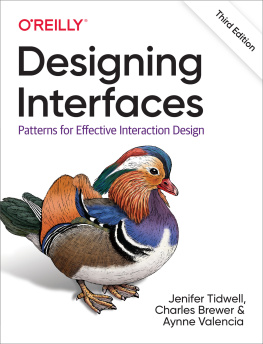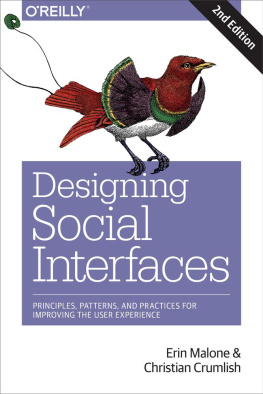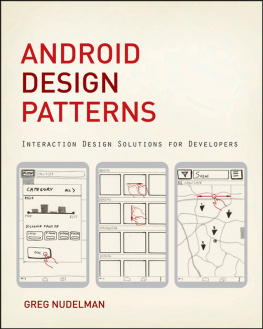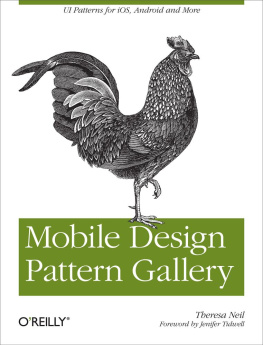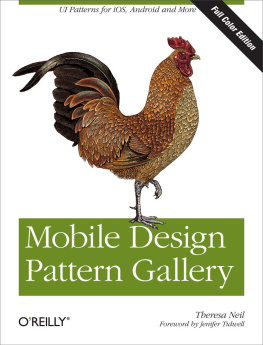Designing Interfaces
by Jenifer Tidwell , Charles Brewer , and Aynne Valencia
Copyright 2020 Jenifer Tidwell, Charles Brewer, and Aynne Valencia. All rights reserved.
Printed in Canada.
Published by OReilly Media, Inc. , 1005 Gravenstein Highway North, Sebastopol, CA 95472.
OReilly books may be purchased for educational, business, or sales promotional use. Online editions are also available for most titles (http://oreilly.com). For more information, contact our corporate/institutional sales department: 800-998-9938 or corporate@oreilly.com .
- Acquisitions Editor: Jennifer Pollock
- Development Editor: Angela Rufino
- Production Editor: Christopher Faucher
- Copyeditor: Octal Publishing, LLC
- Proofreader: Carol Keller
- Indexer: Ellen Troutman
- Interior Designer: David Futato
- Cover Designer: Karen Montgomery
- Illustrator: Rebecca Demarest
- November 2005: First Edition
- December 2010: Second Edition
- January 2020: Third Edition
Revision History for the Third Edition
- 2019-12-18: First Release
See http://oreilly.com/catalog/errata.csp?isbn=9781492051961 for release details.
The OReilly logo is a registered trademark of OReilly Media, Inc. Designing Interfaces, the cover image, and related trade dress are trademarks of OReilly Media, Inc.
The views expressed in this work are those of the authors, and do not represent the publishers views. While the publisher and the authors have used good faith efforts to ensure that the information and instructions contained in this work are accurate, the publisher and the authors disclaim all responsibility for errors or omissions, including without limitation responsibility for damages resulting from the use of or reliance on this work. Use of the information and instructions contained in this work is at your own risk. If any code samples or other technology this work contains or describes is subject to open source licenses or the intellectual property rights of others, it is your responsibility to ensure that your use thereof complies with such licenses and/or rights.
978-1-492-05196-1
[TI]
Preface to the Third Edition
The more things change, the more they stay the same.
Were approaching the 15-year anniversary of the original publication of this book, Designing Interfaces. And its been 10 years since the second edition. Its worth looking at whats changed and what hasnt, and what it means for interface design and people who interact with software.
Since then, the big change is that technology and software accelerated their growth and spread in an ever-increasing way. This trend is not stopping. Today, we interact with software in almost every aspect of our daily lives; for work, leisure, communicating, shopping, learning, and more. The list of devices and things with software smarts and internet connectivity is exploding: cars, smart speakers, televisions, toys, watches, homes. Screen sizes and types vary, and an explosion of interfaces that are primarily gesture or voice are found in consumer products. Globally, more than half the population of the planet now accesses the internet. Finally, software is becoming more powerful, more analytical, more predictive, more able to offer smarter insights and operate more independently. In a phrase, its becoming more like us.
Interface design, like everything else, changes to keep up with the changing times. A third edition that tries to be the comprehensive design guide for all the possible interfaces in this increasing complexity would be enormous and never finished.
Why We Wrote This Book
When the opportunity arose to create the third edition of Designing Interfaces, we were excited for a number of reasons. First, we couldnt help but be impressed that we have seen this title regularly on our colleagues desks and shelves over the years, a constant companion. Indeed, Designing Interfaces has been a lasting source of information and inspiration for many designers for a decade and a half. Its a privilege to have a hand in updating this stalwart text.
The timing was right, too. The speed of change in technology and our digital lives has increased dramatically. Design is undergoing rapid change, as well. Designing Interfaces needed to be updated. That meant a twin opportunity of bringing forward what makes this book special and then sharpening and freshening the focus of the book.
The vision we said Yes! to is this: we see the need for a new guidebook to design. It would help make sense of this new state of software design. We wanted to write a guidebook that would have broad appeal, one that would be kept on hand by designers and teams of all stripes, from novice to seasoned. Although its no longer possible for a single tome to be a guide to all emerging digital channels and specializations, we still wanted a guidebook that would speak to the home base of interaction design as we understand it today. For this reason, we decided to focus this third edition on screen-based interaction design for web and mobile. What we removed is outlined in just a moment. Finally, we wanted to write a guidebook that offers a unique point of view. What makes Designing Interfaces unique and relevant is obviously its design patterns. We added some patterns of our own, specifically those aspects of human cognition and behavior that influence our design work. We hope we have a guidebook that brings design patterns to a new audience.
Design Patterns Remain Relevant
We asked ourselves, How is design and Designing Interfaces relevant? The answer is the design patterns. Design pattern s come from the ways people perceive and use software. Human senses and psychology dont change, and these patterns work with these, not against them. The patterns are evergreen also because they are based on the tasksbig and smallthat people want to do with software. People will always want to use screens to search for things; enter data; create, control, or manipulate digital objects; manage money and payments; and send and receive information, messages, and files to other people. Design patterns form the building blocks for UIs for any screen. Whats more, thinking in patterns and looking for emergent ones is very much in line with how software and interaction design is carried out today.
Software Is Systems Now
Now more than ever, designers, entrepreneurs and developers, and companies have an effective toolset to design and build great software.
The design and software world has evolved into a systems, components, and modules approach. Starting from scratch to design or code something entirely new is not the norm anymore. There are numerous user interface (UI) toolkits and frameworks that allow you to create screen-based interfaces that work across many screen sizes quickly. These component libraries should be regarded as a way to rapidly get to a solid base. They are not a ceiling for design innovation: they are the floor.
The services and middleware that power software are increasingly an integration of separately owned and operated services, as well. Why develop your own registration system when you can sign up with Google, Facebook, and others? Why develop your own analytics and report-building software when you can integrate your choice of robust, customizable business intelligence platforms? Why host your own mobile platform when you have Amazon Web Services? The same is true for all of your HR processes, all of your IT infrastructure. We increasingly assemble, rather than create

